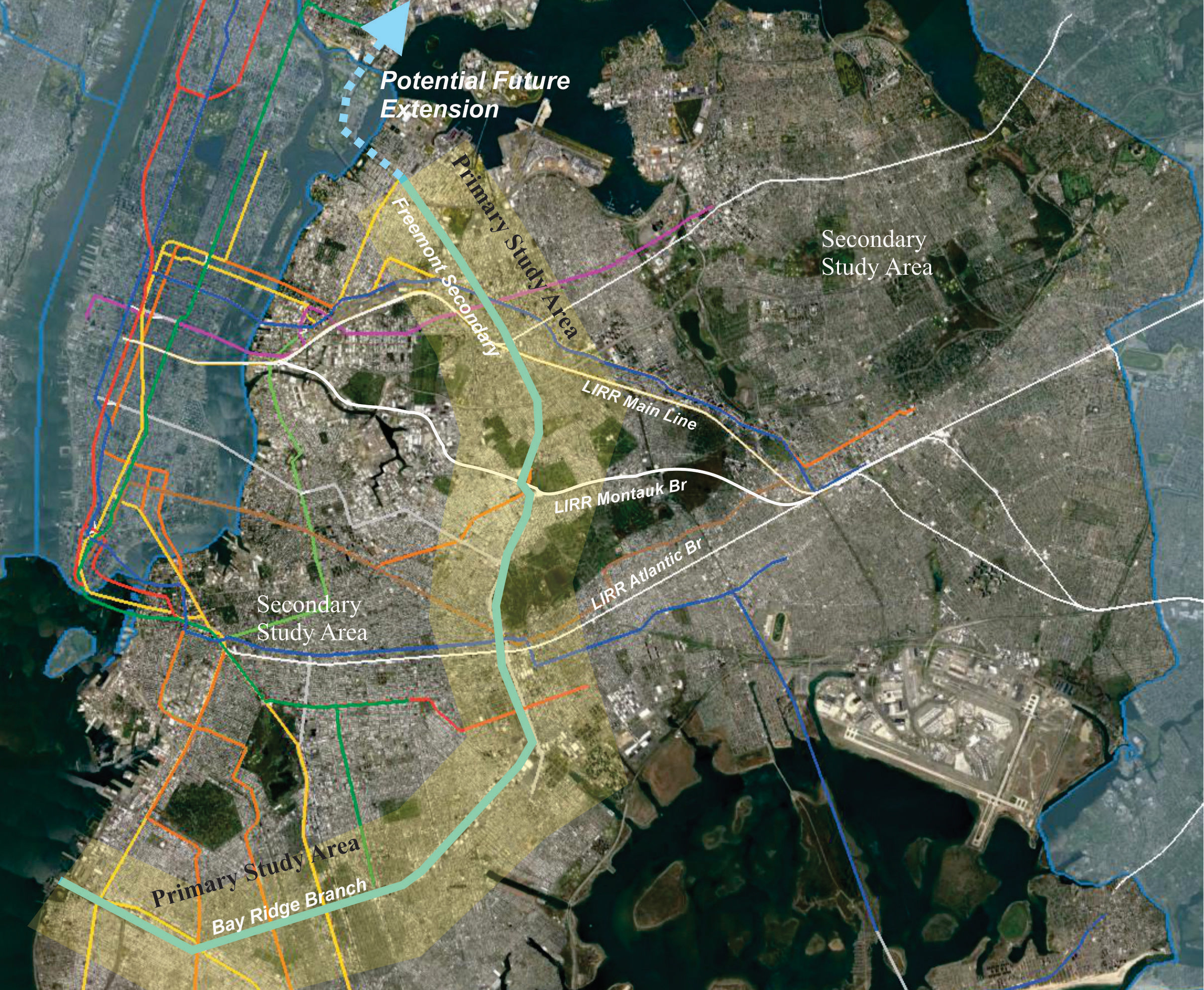The MTA recently announced it would study the feasibility of a bold plan to turn some under-used freight lines in Brooklyn and Queens into "The Triboro," a rail line that crosses 17 subway lines and four LIRR branches. Supporters say it would revolutionize cross-town travel and connect parts of the city that have dramatically changed since the subway system was built. Opponents say it's an overpriced solution. Let the debate begin!
The Triboro Must Never Leave the Station

By Larry Penner
Reopening the Bay Ridge LIRR Branch running to Ridgewood, Queens for passenger service makes no sense. It is a waste of time and money.
In 2016, the Regional Planning Association updated release of an old proposal from 1996 for construction of the Triboro X new rail service. Just how did the RPA come up with a potential cost of $2 billion? My experiences of over 31 years in the transportation field tell me it could easily cost several billion more. Any proposed extension of the route from Bay Ridge, Brooklyn to Staten Island would require construction of a tunnel and additional station at the St. George Staten Island Ferry Terminal. This could also provide a connection to the Staten Island Rapid Transit station and system.. This additional work alone could easily cost $5 billion.
The proposed full route will traverse dozens of neighborhoods in the Bronx, Queens and Brooklyn impacting several hundred thousand people living nearby. How will they react to potential noise and visual impacts of a new elevated subway? There are serious legal and operational issues to be resolved with the Federal Railroad Administration, which has regulatory jurisdiction over significant portions of the proposed route adjacent to existing active freight tracks. Subway and freight trains have to coexist on the same narrow corridor.
Project costs will probably include a series of new stations with elevators and escalators. This is necessary to provide transfer capacity with 17 subway and four commuter rail stations that intersect along the route. (Each connecting subway or commuter rail station could easily cost from $50 to $100 million; imagine the costs of escalators and including elevators to be in compliance with the Americans with Disabilities Act.
Add to that new track, signals, power, power substations and a hundred or more new subway cars at $2 million per car. This additional fleet would require construction of a new maintenance, operations and storage yard (several hundred million). What community would be willing to host such a facility? There is also a potential serious conflict at the Bay Ridge terminus. This is also a potential site for a connection to the proposed $10-billion Cross Harbor Freight Tunnel project.
History has told us that construction of most major new transportation system expansion projects have taken decades. There is the completion of feasibility studies, environmental reviews, planning, design, engineering, real estate acquisition, permits, procurements, budgeting, identifying and securing funding to pay for all of the above before construction can start.
There is not enough space here to list many other transportation projects in NYC whose costs range from $50 million to $8 billion that might be considered a higher priority than the "Triboro X" line. We should not initiate any new system expansion projects until each operating agency — NYC Transit bus and subway, MTA bus, LIRR, Metro-North, New Jersey Transit and PATH — has reached a state of good repair for existing fleet, stations, signals, interlockings, track, power, power substations, yards and shops, and that all stations are ADA accessible.
Let's insure safe and reliable service for the current system before expansion.
Larry Penner is a transportation historian, writer and advocate who worked 31 years for the Federal Transit Administration in New York.
'The Triboro' is key to a changing city
By Kate Slevin
More than two decades after Regional Plan Association first proposed the Triboro line, the above-ground rail line running through the Bronx, Brooklyn and Queens is moving forward as the Metropolitan Transportation Authority begins to study bringing passenger service to a chunk of existing rail in Brooklyn and Queens.
Why now? New York City’s transit system was designed to bring people into Manhattan, yet 50 percent of job growth in the last 15 years has been in the outer boroughs. Our transit infrastructure hasn’t caught up with our economy and development patterns, and it could cost us. Dozens of council members, state legislators, and advocates recognize this and have been urging the MTA to study the Triboro.
The Triboro would serve more than 100,000 riders in underserved neighborhoods each day, cost less than the recent 7 subway line's half-mile extension from the 42nd Street station to the Hudson Yards on 34th Street, and connect riders to 17 subway lines and four commuter-rail lines.
It would link manufacturing and industrial hubs in Hunts Point, northern Astoria, Maspeth, and Bay Ridge, connecting outer-borough residents to job opportunities and helping to sustain the city’s manufacturing sector. Large retail centers like Jackson Heights and Middle Village would become more accessible. Transfers from the Triboro to Metro-North and the Long Island Rail Road would give residents streamlined access to suburban economic centers in the Hudson Valley, Long Island, and Connecticut.
By expanding to transit-starved neighborhoods, the Triboro would enable outer-borough residents to actually leave their cars at home or forgo a ride-share, driving down greenhouse-gas emissions in many neighborhoods that are already overburdened by pollution.
Sounds like a slam dunk, right? If you’re familiar with the cost of building rail transit around here, the idea of a train line stretching across three boroughs might give you pause, or even a little heartburn.
New York is the world's most expensive city in which to build rail transit. Our 2018 report on MTA cost overruns concluded that “high costs and delays are embedded in every aspect of public project delivery.” Overruns appear to be endemic to our rail projects from the Second Avenue Subway to East Side Access, so what makes the Triboro any different?
The tracks are already there. The project leverages existing infrastructure and complements the existing transit network. The rail right-of-way for Triboro is intact and fully grade-separated, requiring few structural improvements to reactivate. It could be built faster and more cheaply than other recent, large-scale transit projects in the New York region.
In addition, Gov. Cuomo and MTA leadership recognize the need for change and they’ve begun to take concrete steps to expedite project delivery and lower costs.
Regardless, building public transportation is expensive. Yet not building public transportation can be more expensive; the costs are just hidden and delayed. Our subways fell into crisis in 2018 primarily because of decades of disinvestment in the transit system.
Some may argue we can’t afford Triboro. But can we afford unmitigated pollution from automobiles? Can we afford a lack of access to opportunities in outer-borough communities? Can we afford to gamble the strength of our growing job centers by relying only on our existing Manhattan-centric transit system?
We’ll have hard numbers on the cost of construction once the MTA completes its feasibility study on the existing rail in Brooklyn and Queens. But even working with placeholders, you can do the math.
Kate Slevin (@SlevinKate) is senior vice president of state programs and advocacy at Regional Plan Association.
City & State NY is hosting a full day New York in Transit summit on Jan. 30 at the Museum of Jewish Heritage. This summit will bring together experts to assess the current state of New York’s transportation systems, break down recent legislative actions, and look towards the future of all things coming and going in New York. Join Keynote Speaker Polly Trottenberg, commissioner of the NYC Department of Transportation, along with agency leaders, elected officials, and advocates. Use the code STREETSBLOG for a 25-percent discount when you RSVP here!







